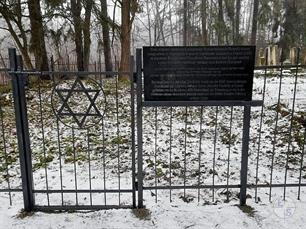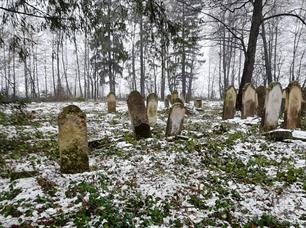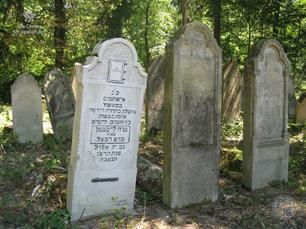Banyliv-Pidhirnyy
Chernivtsi district, Chernivtsi region
Sources:
- Russian Jewish encyclopedia. Translated from Russian by Eugene Snaider
- Isaak Brecher. Mold. Banila / Geschichte der Juden in der Bukowina (History of the Jews in the Bukowina), vol. II. Edited by Hugo Gold. Tel Aviv: Olamenu, 1962. Translated from German by Jerome Silverbush z”l, JewishGen, Inc
Photo:
- European Jewish Cemeteries Initiative. Banyliv-Pidhirnyy Jewish Cemetery
- Baruch Eylon, Center for Jewish Art. Jewish cemetery in Banyliv Pidhirnyi
- Russian Jewish encyclopedia. Translated from Russian by Eugene Snaider
- Isaak Brecher. Mold. Banila / Geschichte der Juden in der Bukowina (History of the Jews in the Bukowina), vol. II. Edited by Hugo Gold. Tel Aviv: Olamenu, 1962. Translated from German by Jerome Silverbush z”l, JewishGen, Inc
Photo:
- European Jewish Cemeteries Initiative. Banyliv-Pidhirnyy Jewish Cemetery
- Baruch Eylon, Center for Jewish Art. Jewish cemetery in Banyliv Pidhirnyi
Banyliv-Pidhirnyy (ukr. Банилів-Підгірний), in the 19th - beginning of the 20th century - the village of Banila Moldavska of the Storozhinets eldership of the Duchy of Bukovina as part of Austria-Hungary. In 1918-40 - the village of Banila-on-Seret as part of Romania, in 1940–91 - as part of the Ukrainian SSR.
In 1946, the village of Banila was renamed Banyliv-Pidhirnyy.
In 1930, 688 Jews lived in Banyliv-Pidhirnyy.
The three sawmills, the distillery and the estate were in Jewish hands. The occupations of the Jews included civil service and workers in industry or farming. Many had small businesses dealing with lumber or groceries and a large number farmed their own land.
Their political importance corresponded to their commercial significance. For decades, the mayor was a Jew, the last being Mendel Gottesmann and the town secretaries were Dinghe Druckmann, Herzl Haber and Seide Koppler. This situation changed when the land came under Romanian rule but the business position of the Jews remained unaffected for the first few years of Romanian domination.
The Druckmann, Haber, Gabor and Surkis families were highly respected. The community had its own rabbi, the last one being the Rabbi Mordechai Horowitz. They maintained a ritual bath with their own ritual slaughterer. There were three synagogues. The leaders of the community were elected. The last president of the Jewish community was Salamon Sussmann, his deputy was Abraham Koffler. The doctors were Dr. Josef Horn and Dr. Isiu Salzberger. Also the pharmacists were Jewish.
The Jews of the town for the most part were enthusiastic Zionists. The Zionist organization was led by Isaak Brecher. Thanks to the “nationalistic Jewish” education, the youth used the Hebrew language in every day conversation. The teacher Bergstein was chiefly responsible for this, but also the efforts of the teachers Auerbach, Ornstein, Stein and Singer in the Hebrew school deserve unrestricted praise. At the urging of Jakob Brecher, the estate owner Meier Gross contributed a “Jewish House” in which the school, the Zionist organization, the library and the offices of the Jewish community as well as a hall for celebrations were to be found.
This intellectual activity stopped when the Russians occupied the town in 1941. The physical destruction began with the deportation of the respected families Suessmann, Singer and Surkis and the Rosenzweig brothers to Siberia where most of them perished.
The goal of the Romanian Soldatesk, who were under the influence of National Socialism was the devilish work of the complete destruction of the Jews. When the Romanians retreated from Banila in 1940, they took the Jewish citizens Moses Haller, Natan Druckmann and Ire Lupowicz and executed them in Suceava. When they returned in July, 1941, one of the first victims was the previously mentioned Jakob Brecher, a Talmud scholar who had a library on Jewish subjects with almost 5000 volumes. He was murdered in a bestial way. With him 18 families fell to the bullets of the criminals. Some of the names are: Rachel Sucher, Nitel Druckmann, Frieda Sussmann, Jakob Fleischer, Mendl Safran, Baruch Singer, Libzi Welloch.
The remaining Jews were driven with blows to Storozynetz where at first they were held captive in a ghetto built by themselves under inhuman conditions and then taken to Bessarabien where the great dying began. Finally, they were driven half naked and starving across the Dniester to Transnistrien. Those who didn't die from the stress along the way, died later in Berschad from hunger and typhus. The few survivors found themselves scattered in Romania and some found the longed for homeland in Israel.
In 1946, the village of Banila was renamed Banyliv-Pidhirnyy.
In 1930, 688 Jews lived in Banyliv-Pidhirnyy.
The three sawmills, the distillery and the estate were in Jewish hands. The occupations of the Jews included civil service and workers in industry or farming. Many had small businesses dealing with lumber or groceries and a large number farmed their own land.
Their political importance corresponded to their commercial significance. For decades, the mayor was a Jew, the last being Mendel Gottesmann and the town secretaries were Dinghe Druckmann, Herzl Haber and Seide Koppler. This situation changed when the land came under Romanian rule but the business position of the Jews remained unaffected for the first few years of Romanian domination.
The Druckmann, Haber, Gabor and Surkis families were highly respected. The community had its own rabbi, the last one being the Rabbi Mordechai Horowitz. They maintained a ritual bath with their own ritual slaughterer. There were three synagogues. The leaders of the community were elected. The last president of the Jewish community was Salamon Sussmann, his deputy was Abraham Koffler. The doctors were Dr. Josef Horn and Dr. Isiu Salzberger. Also the pharmacists were Jewish.
The Jews of the town for the most part were enthusiastic Zionists. The Zionist organization was led by Isaak Brecher. Thanks to the “nationalistic Jewish” education, the youth used the Hebrew language in every day conversation. The teacher Bergstein was chiefly responsible for this, but also the efforts of the teachers Auerbach, Ornstein, Stein and Singer in the Hebrew school deserve unrestricted praise. At the urging of Jakob Brecher, the estate owner Meier Gross contributed a “Jewish House” in which the school, the Zionist organization, the library and the offices of the Jewish community as well as a hall for celebrations were to be found.
This intellectual activity stopped when the Russians occupied the town in 1941. The physical destruction began with the deportation of the respected families Suessmann, Singer and Surkis and the Rosenzweig brothers to Siberia where most of them perished.
The goal of the Romanian Soldatesk, who were under the influence of National Socialism was the devilish work of the complete destruction of the Jews. When the Romanians retreated from Banila in 1940, they took the Jewish citizens Moses Haller, Natan Druckmann and Ire Lupowicz and executed them in Suceava. When they returned in July, 1941, one of the first victims was the previously mentioned Jakob Brecher, a Talmud scholar who had a library on Jewish subjects with almost 5000 volumes. He was murdered in a bestial way. With him 18 families fell to the bullets of the criminals. Some of the names are: Rachel Sucher, Nitel Druckmann, Frieda Sussmann, Jakob Fleischer, Mendl Safran, Baruch Singer, Libzi Welloch.
The remaining Jews were driven with blows to Storozynetz where at first they were held captive in a ghetto built by themselves under inhuman conditions and then taken to Bessarabien where the great dying began. Finally, they were driven half naked and starving across the Dniester to Transnistrien. Those who didn't die from the stress along the way, died later in Berschad from hunger and typhus. The few survivors found themselves scattered in Romania and some found the longed for homeland in Israel.

- Home
- Shtetls
- Vinnytsia region
- Volyn region
- Dnipro region
- Donetsk region
- Zhytomyr region
- Zakarpattia region
- Zaporizhzhia region
- Ivano-Frankivsk region
- Kyiv region
- Kropyvnytskyi region
- Luhansk region
- Lviv region
- Mykolayiv region
- Odessa region
- Poltava region
- Rivne region
- Sumy region
- Ternopil region
- Kharkiv region
- Kherson region
- Khmelnytskyi region
- Chernihiv region
- Chernivtsi region
- Cherkasy region
- Crimea
- Synagogues
- Cemeteries
- Objects & guides
- Old photos
- History
- Contact
Jewish towns of Ukraine
My shtetl
My shtetl
Donate
Jewish towns of Ukraine


